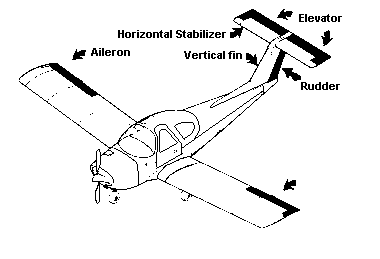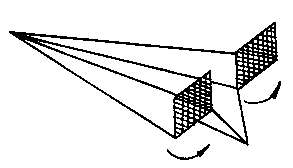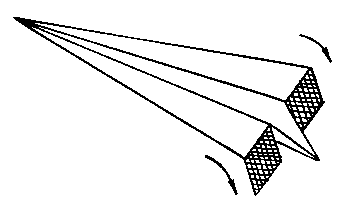 |
|||||
| Home | Research | For Teachers | HISTORY Level 1 Level 2 Level 3 |
PRINCIPLES Level 1 Level 2 Level 3 |
CAREER Level 1 Level 2 Level 3 |
| Gallery | Hot Links | What's New! | |||
| Web Administration and Tools | |||||
 |
|||||
| Home | Research | For Teachers | HISTORY Level 1 Level 2 Level 3 |
PRINCIPLES Level 1 Level 2 Level 3 |
CAREER Level 1 Level 2 Level 3 |
| Gallery | Hot Links | What's New! | |||
| Web Administration and Tools | |||||
![]()
Cars go only left or right, but planes must be steered up or down as well. A plane has parts on its wings and tail called control surfaces to help it. These can be demonstrated by use of folded paper gliders and balsa gliders. Let's start with an experiment to illustrate how a plane is controlled.
The finished glider can be held together at the bottom with a paper cup. The paper clip can also be used for a balance. Experiment with the glider, moving the clip up or back as needed to obtain proper balance.

Experiment further by changing the position of the wings.
Press ![]() to see Animation
for how to create a paper glider.
to see Animation
for how to create a paper glider.
Real planes have segments called ailerons inserted in the wings and segments called rudders and elevators inserted respectively in the vertical fin and horizontal stabilizer. The pilot controls their position from the airplane cockpit. When the pilot moves them into the airstream, they cause the plane to react to air pressure.The pilot uses them to go right or left and also up and down.

Fold the back edges of the paper glider up, as in the diagram below. When you throw the glider, the tail should go down and the nose should point up. It may take some practice to get the controls set so the glider does what you want it to do.
To make the plane climb, the pilot moves the controls so that the elevators tilt up in the same way that you folded the back edges of the glider. The air hitting the elevators pushes the tail of the plane down, tilting the nose upward, so that the plane can climb.

Fold the back edges of the glider down. When you throw the glider, the tail should go up and the nose should go down. This same thing happens when the pilot tilts the elevators downward.

Turn the vertical fin on the glider a little to the right; the glider will fly toward the right. The pilot moves the rudder to the right for a right turn, but must also bank (lean) the plane for the turn, the same as you would do if you were turning on a bicycle. (You would lean to the right for a right turn.) The pilot tilts the plane to one side by using the ailerons. When one tilts up the other tilts down.
To tilt the plane to the right, the pilot tilts the left aileron down so the left wing is pushed up. The right aileron is tilted up so the right wing will be pushed down. You can do the same thing with a paper glider. (This principle can be illustrated also by suspending the glider in a wind tunnel.)

For a left turn, the pilot reverses the process described above.
Send all comments to ![]() aeromaster@eng.fiu.edu
aeromaster@eng.fiu.edu
© 1995-98 ALLSTAR Network. All rights reserved worldwide.
Updated: February 23, 1999